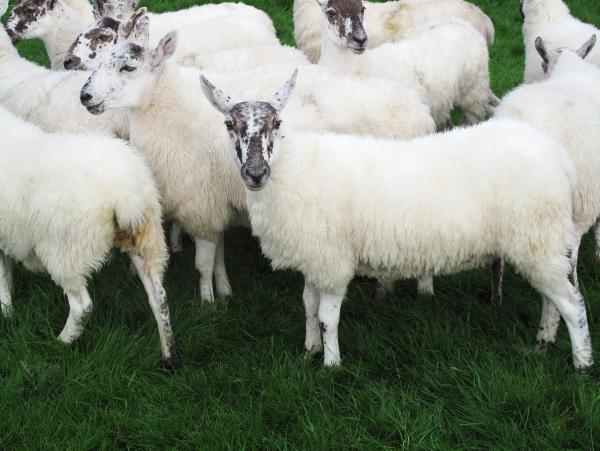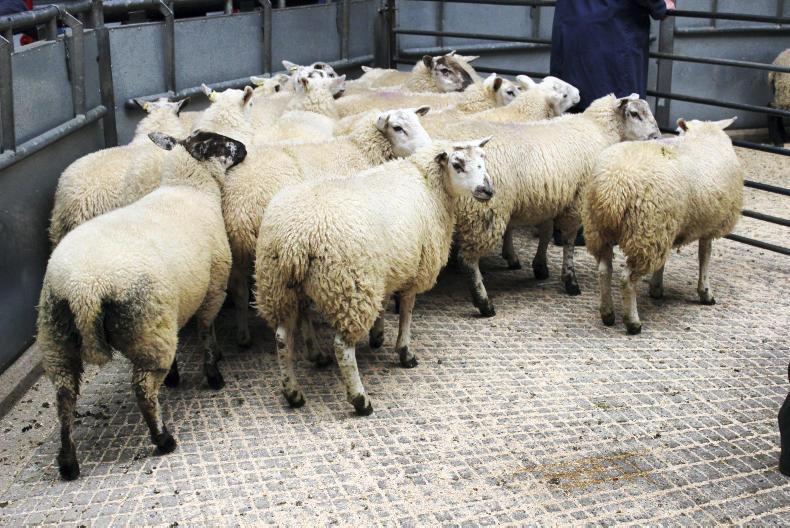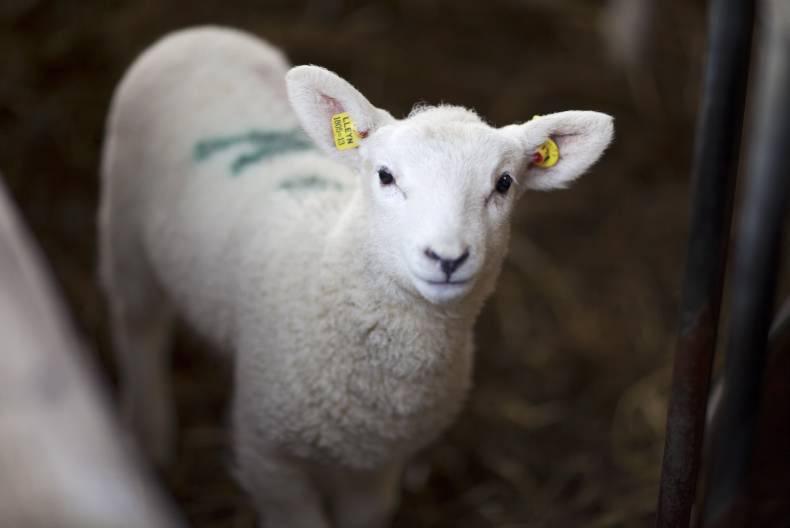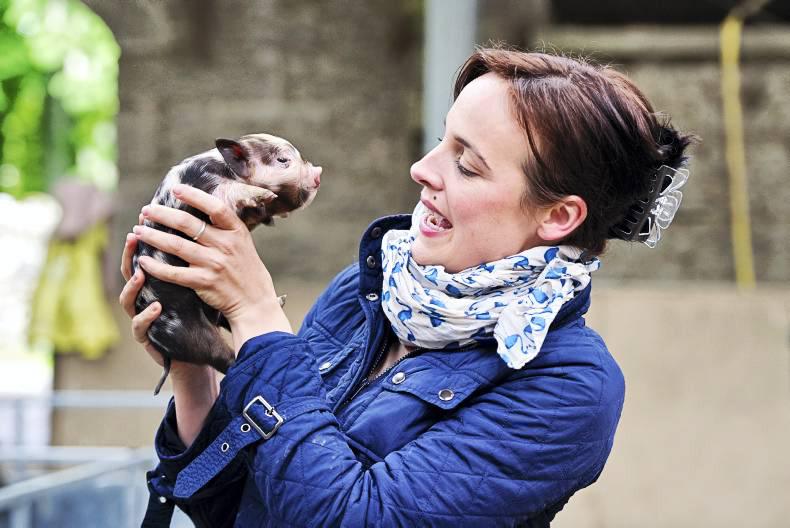With autumn breeding sales in full swing, now is the time to pose some questions regarding the decisions made at those sales.
Not enough thought is put into replacing a ewe. It is the single biggest cost in keeping a ewe, greater than meal, silage, fertilizer or veterinary bills.
So, what should your targets be when selecting breeding ewes?
Litter size
Is your target 1.3, 1.5 or 1.7 lambs sold/ewe to ram. Ewes at the correct condition at mating will maximise litter size from an individual breed. But there is also a difference between breeds – Table 1 below shows the relative difference.
Lambs reared per ewe combined with carcase weight gives lamb meat output per ewe. Some farms are not maximizing litter size but are making up with heavier carcases.
For example, 1.44 lambs reared at 19.5kg carcase is equivalent to 1.55 sold at 18.1kg carcase. Both ewes produced 28kg of carcase. Producing heavier carcases requires good lamb selection and frequent drafting, otherwise there is an increased chance of overfat carcases.
Increasing lambs reared will increase net margin per ewe. This will usually require a higher litter size, which means more triplets as shown in Table 2.
High litter sizes require skilled supervision at lambing. Otherwise, the increase in triplets could result in high mortality levels.
Carcase quality
If a high proportion of Us are required, then ewe shape must be excellent. This may require lowland-type ewes rather than hill ewes, unless Beltex rams are used. Late maturing breeds are necessary where maximum carcase weight is targeted.
Closed flock
A closed flock will limit replacement options. It gives complete control of the type of ewe you want and minimises risk of disease introduction. However, it is best suited to large flocks.

What option suits you?
Buying local ewes: Purchased at marts but not specifically bred as replacement stock. Litter size is variable and there is always the risk of disease, especially where you buy from a number of flocks. This option may suit small flocks where it would not be practical to breed replacements.
A better option might be to buy direct from a known farm. You can easily monitor litter size, disease and performance of this stock. If satisfied, you can return to the same farm each year.
Specifically-bred ewes (e.g. Borris/Greyfaces/Mules/Belclares): You will probably have to travel to acquire these. They will give a very uniform sheep flock. The influence of hill ewes make them good mothers.
Special sales of these breeds are well advertised, for example the very successful Mule and Greyface sales at Ballinrobe Mart, supplying breeding stock to farmers throughout the country.
Replacement flock: Here the farm has two flocks – a small replacement flock and a main flock (as shown in Table 3). A replacement ram is mated to the small flock, which produces suitable ewe lambs for the main flock.
For example, take a 200-ewe flock. Mate 60 ewes to replacement rams, which will give approximately 40 ewe lambs. The remaining 140 ewes require about 30 replacements per year, selected from the 40 ewe lambs. To maintain the flock of 60, 15 ewes need to be purchased each year.
This option is ideal where farmers complain that their flocks have gone too Suffolk-like. A suitable replacement ram mated to 60 of these Suffolk ewes will produce ideal replacements.
Crossbreeding: This is where two breeds are continuously backcrossed to produce replacements (demonstrated in the example in Table 4).
Each autumn, 40 ewes each are given to a replacement ram and a meat ram. The females from these matings are retained. The ewe flock will not be uniform in looks because half the flock will have two thirds of one breed and the other half a different breed. Crossbreeding gives total control of your breeding flock. The type and breed of ram you select will dictate prolificacy and shape of ewe. In addition, it maintains a closed flock.
Maternal sires
The growing wealth of information now flowing from Sheep Ireland on maternal traits of €uroStar rams should be used when buying rams to produce own replacements. Also when buying ewes, check if maternal figures are available for their sire.
Your decision
It is horses for courses and personal preferences that often dictate ewe and ram breed used. The important thing is that it is planned.
Read more
Lambing 500 more sheep in six years
Slaughter performance varying greatly in 2017
With autumn breeding sales in full swing, now is the time to pose some questions regarding the decisions made at those sales.
Not enough thought is put into replacing a ewe. It is the single biggest cost in keeping a ewe, greater than meal, silage, fertilizer or veterinary bills.
So, what should your targets be when selecting breeding ewes?
Litter size
Is your target 1.3, 1.5 or 1.7 lambs sold/ewe to ram. Ewes at the correct condition at mating will maximise litter size from an individual breed. But there is also a difference between breeds – Table 1 below shows the relative difference.
Lambs reared per ewe combined with carcase weight gives lamb meat output per ewe. Some farms are not maximizing litter size but are making up with heavier carcases.
For example, 1.44 lambs reared at 19.5kg carcase is equivalent to 1.55 sold at 18.1kg carcase. Both ewes produced 28kg of carcase. Producing heavier carcases requires good lamb selection and frequent drafting, otherwise there is an increased chance of overfat carcases.
Increasing lambs reared will increase net margin per ewe. This will usually require a higher litter size, which means more triplets as shown in Table 2.
High litter sizes require skilled supervision at lambing. Otherwise, the increase in triplets could result in high mortality levels.
Carcase quality
If a high proportion of Us are required, then ewe shape must be excellent. This may require lowland-type ewes rather than hill ewes, unless Beltex rams are used. Late maturing breeds are necessary where maximum carcase weight is targeted.
Closed flock
A closed flock will limit replacement options. It gives complete control of the type of ewe you want and minimises risk of disease introduction. However, it is best suited to large flocks.

What option suits you?
Buying local ewes: Purchased at marts but not specifically bred as replacement stock. Litter size is variable and there is always the risk of disease, especially where you buy from a number of flocks. This option may suit small flocks where it would not be practical to breed replacements.
A better option might be to buy direct from a known farm. You can easily monitor litter size, disease and performance of this stock. If satisfied, you can return to the same farm each year.
Specifically-bred ewes (e.g. Borris/Greyfaces/Mules/Belclares): You will probably have to travel to acquire these. They will give a very uniform sheep flock. The influence of hill ewes make them good mothers.
Special sales of these breeds are well advertised, for example the very successful Mule and Greyface sales at Ballinrobe Mart, supplying breeding stock to farmers throughout the country.
Replacement flock: Here the farm has two flocks – a small replacement flock and a main flock (as shown in Table 3). A replacement ram is mated to the small flock, which produces suitable ewe lambs for the main flock.
For example, take a 200-ewe flock. Mate 60 ewes to replacement rams, which will give approximately 40 ewe lambs. The remaining 140 ewes require about 30 replacements per year, selected from the 40 ewe lambs. To maintain the flock of 60, 15 ewes need to be purchased each year.
This option is ideal where farmers complain that their flocks have gone too Suffolk-like. A suitable replacement ram mated to 60 of these Suffolk ewes will produce ideal replacements.
Crossbreeding: This is where two breeds are continuously backcrossed to produce replacements (demonstrated in the example in Table 4).
Each autumn, 40 ewes each are given to a replacement ram and a meat ram. The females from these matings are retained. The ewe flock will not be uniform in looks because half the flock will have two thirds of one breed and the other half a different breed. Crossbreeding gives total control of your breeding flock. The type and breed of ram you select will dictate prolificacy and shape of ewe. In addition, it maintains a closed flock.
Maternal sires
The growing wealth of information now flowing from Sheep Ireland on maternal traits of €uroStar rams should be used when buying rams to produce own replacements. Also when buying ewes, check if maternal figures are available for their sire.
Your decision
It is horses for courses and personal preferences that often dictate ewe and ram breed used. The important thing is that it is planned.
Read more
Lambing 500 more sheep in six years
Slaughter performance varying greatly in 2017












SHARING OPTIONS